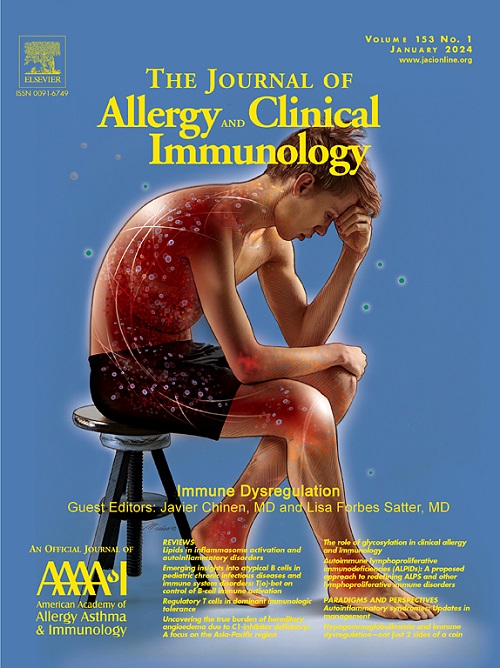Impact of climate change on aerobiology, rhinitis, and allergen immunotherapy: Work Group Report from the Aerobiology, Rhinitis, Rhinosinusitis & Ocular Allergy, and Immunotherapy, Allergen Standardization & Allergy Diagnostics Committees of the American Academy of Allergy, Asthma & Immunology.
IF 11.4
1区 医学
Q1 ALLERGY
引用次数: 0
Abstract
Climate change is imposing a profound effect on health conditions triggered by environmental exposures. Climate change has affected aeroallergens in numerous ways, including: (1) changes in the vegetation microbiome distribution, (2) increases in C4 grasses globally, (3) increased occurrence of acute weather events, (4) increases in ambient temperature that amplify fungal spore concentration and pollen season duration, and (5) increased allergenicity of pollen and fungi due to exposure to higher levels of carbon dioxide, ozone, and diesel exhaust particles. In addition, greenhouse gases and air pollutants disrupt the epithelial barrier, trigger eosinophilic inflammation, and serve as adjuvants that stimulate IgE-mediated responses. All of these factors have influenced the prevalence and morbidity of allergic rhinitis, nonallergic rhinitis, and chronic rhinosinusitis. Data regarding changes in aeroallergen exposures due to climate change are lacking, and longitudinal sensitization data are rarely available. Allergists need to adapt diagnostic and treatment strategies to limit aeroallergen and air pollutant exposure and facilitate desensitization. Steps needed to address these challenges include: (1) expanding local measurement of pollen and fungal spores, (2) increasing the intensity of allergen avoidance measures, (3) addressing supply chain issues, and (4) promoting collaboration between allergists, insurance companies, aeroallergen manufacturers, and regulatory agencies.气候变化对空气生物学、鼻炎和过敏原免疫疗法的影响:美国过敏、哮喘和免疫学学会空气生物学、鼻炎、鼻窦炎和眼部过敏委员会以及免疫疗法、过敏原标准化和过敏诊断委员会工作组报告》(Work Group Report from the Aerobiology, Rhinitis, Rhinosinusitis & Ocular Allergy, and Immunotherapy, Allergen Standardization & Allergy Diagnostics Committees of the American Academy of Allergy, Asthma & Immunology)。
气候变化正在对环境暴露引发的健康状况产生深远影响。气候变化以多种方式影响空气过敏原,包括:(1)植被微生物群分布的变化,(2)全球C4草的增加,(3)急性天气事件的发生增加,(4)环境温度的升高,真菌孢子浓度和花粉季节持续时间的增加,以及(5)由于暴露于更高水平的二氧化碳、臭氧和柴油尾气颗粒,花粉和真菌的致敏性增加。此外,温室气体和空气污染物破坏上皮屏障,引发嗜酸性炎症,并作为佐剂刺激ige介导的反应。所有这些因素都影响变应性鼻炎、非变应性鼻炎和慢性鼻窦炎的患病率和发病率。由于气候变化导致空气过敏原暴露变化的数据缺乏,纵向致敏数据很少可用。过敏症专家需要调整诊断和治疗策略,以限制空气过敏原和空气污染物的暴露,促进脱敏。应对这些挑战所需的步骤包括:(1)扩大花粉和真菌孢子的本地测量,(2)增加过敏原避免措施的强度,(3)解决供应链问题,(4)促进过敏原医师、保险公司、空气过敏原制造商和监管机构之间的合作。
本文章由计算机程序翻译,如有差异,请以英文原文为准。
求助全文
约1分钟内获得全文
求助全文
来源期刊
CiteScore
25.90
自引率
7.70%
发文量
1302
审稿时长
38 days
期刊介绍:
The Journal of Allergy and Clinical Immunology is a prestigious publication that features groundbreaking research in the fields of Allergy, Asthma, and Immunology. This influential journal publishes high-impact research papers that explore various topics, including asthma, food allergy, allergic rhinitis, atopic dermatitis, primary immune deficiencies, occupational and environmental allergy, and other allergic and immunologic diseases. The articles not only report on clinical trials and mechanistic studies but also provide insights into novel therapies, underlying mechanisms, and important discoveries that contribute to our understanding of these diseases. By sharing this valuable information, the journal aims to enhance the diagnosis and management of patients in the future.

 求助内容:
求助内容: 应助结果提醒方式:
应助结果提醒方式:


